Longtime readers of my EV reviews on Gizmodo Australia will know one key point: I’m not too fond of big cars. I understand the need for them, I get the safety factors, but when you live in the inner-city, most people really don’t need something bigger than, say, a Hyundai Kona. This is why I was so extremely excited to drive the Abarth 500e, the smallest new electric car in Australia.
Now, in fairness, the Abarth shares this title with its less beefy and more affordable brother, the Fiat 500e – the Abarth is simply the specced-up version of that car, and it’s what Gizmodo Australia was allocated for our review period. We’ll point out the key differences between these cars as we go through our review. Additionally, while it’s the smallest new EV in Australia, it’s not the smallest EV to ever be sold in Australia – to my knowledge, that title belongs to the long-defunct Mitsubishi I-MiEV, which I would also very much like to drive someday.
Back to the Abarth 500e: this is, in some ways, my dream car. It’s not big at all, but it has space for moving some things around. It’s stylish, it’s fun to drive, and it’s extremely easy to park and weave on Sydney’s tiny streets.
But it is priced so, so poorly. I get that at least half the price tag is down to the badge, but on the sum of its size, small battery, and its lacking features compared to other similarly priced EVs, a price above $50,000 is a headscratcher.
So, let’s just go through the Abarth 500e, and the Fiat 500e by extension, and talk about if you should consider buying Australia’s smallest EV.
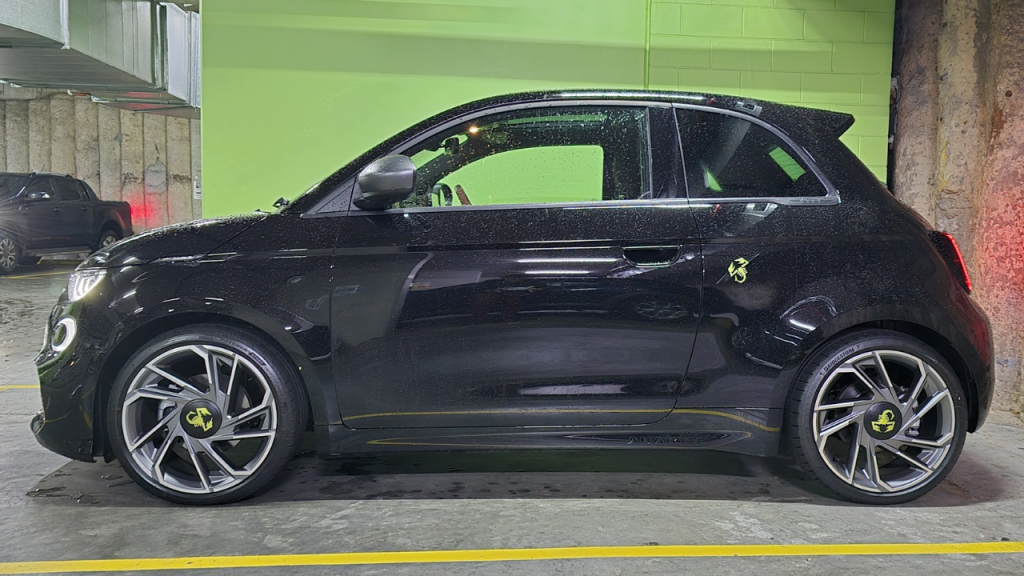
Can you Fi(a)t?
The Fiat/Abarth 500e easily achieves the ‘smallest EV’ title with one simple trick: making the backseat as small and uncomfortable as possible and making the boot barely big enough for a golf bag.
And I can say all that without feeling like I’m punching down, because Fiat’s bread and butter are these tiny cars, and this is just an electric version of an already existing petrol car, the standard 500; the hero car of the Fiat badge.
But don’t write all of this off as ‘impractical’. I managed to pull off a fairly bulky IKEA haul in this car, fitting in two occupants, two assembled chairs, several boxes, and a new doona. For odds and ends of the bulky variety, you can rely on the 500e to a sensible extent, but don’t go assuming that you’ll fit a couch in this thing. If you want a volume rating, it can fit 185L in the back, or 550L with the back seats folded down.
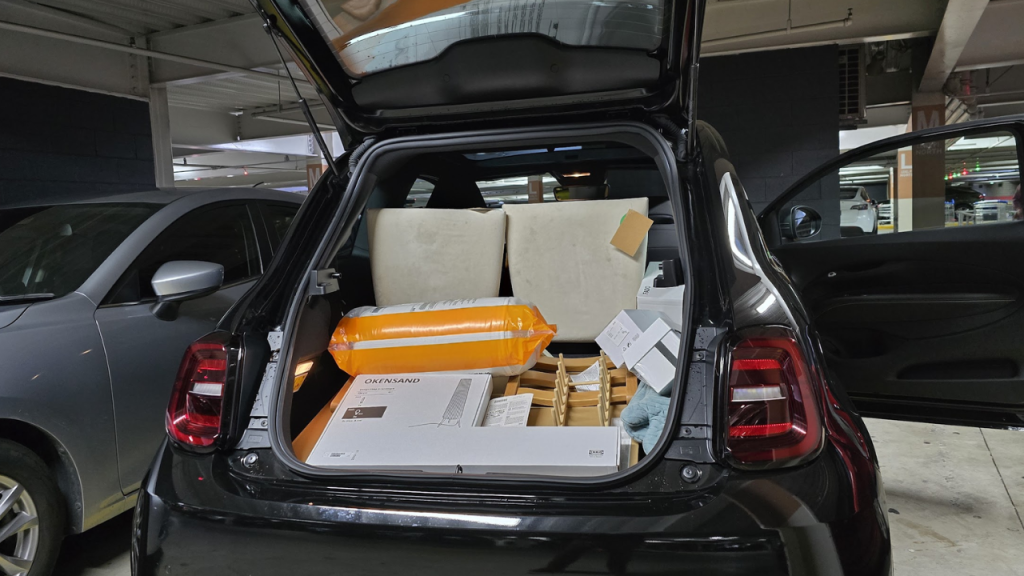
Separately, I did manage to fit four passengers in this car, and while it wasn’t comfortable for all of us, it was indeed possible. It’s at the very end of bearable, with the rear windows unable to be rolled down, and backseat comfort entirely reliant on telling those in the front seats to bring them forward a bit. If you’re six feet or taller, you’ll probably want to avoid riding as a passenger in this car, but you’d be fine in the front seats.
It goes without saying that focusing on such a small niche, small cars, comes with a significant tradeoff. By my count, the Fiat 500e and the Abarth 500e are the only electric cars in Australia that don’t come with an ANCAP five-star safety rating – four is as high as the 500e goes. We don’t typically focus on ANCAP for this fact, but we’re not going to skip it in this case.
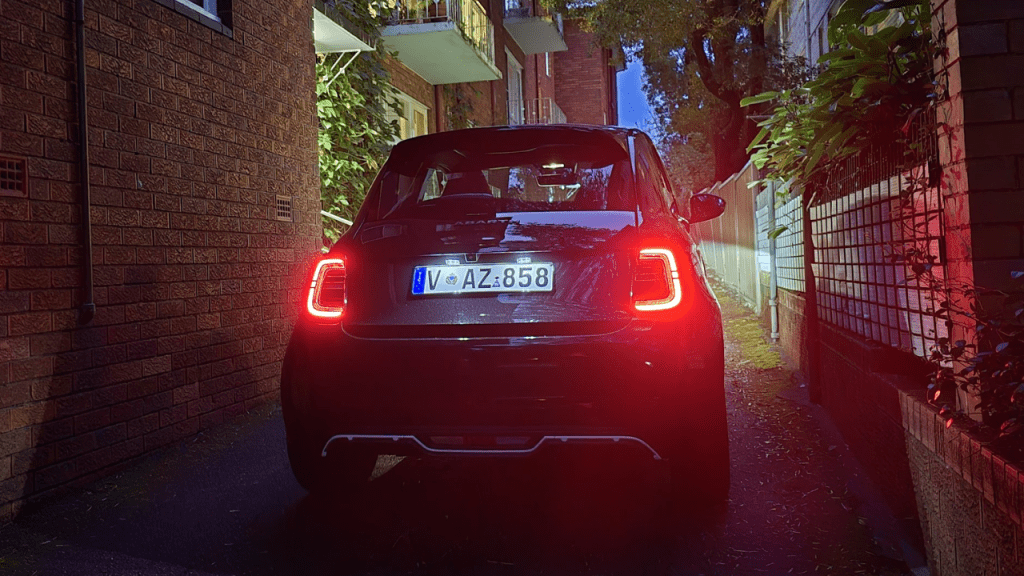
Let’s take it Abarth
Let’s chat about comparisons.
The Abarth 500e comes fitted with a 113.7kW (235Nm) engine, while the standard Fiat come switch an 87kW (220Nm) motor. Those specs mean a difference when flooring it – the Abarth can pull off a 0-100km/h speed in just seven seconds, while the Fiat can do it in nine. Neither of these are bad, but slightly bigger EVs (at cheaper price points) leave them in the dust.
The spec point that’ll keep most people from buying the Abarth 500e is the battery – and I don’t blame them, I absolutely subscribe to the fact that Aussies need a certain amount of assurance when travelling between hubs like Newcastle and Sydney, which the 500e would struggle with. The Abarth 500e can pull off a WLTP range of 253km (315km in the Fiat), but as normal, you’ll see that range shrink on highways. Both models come with 17-inch wheels and maximum DC charging speeds of 85kW (11kW AC). It’s not a terrible charging capacity, but certainly not what I’d want for the price tag.
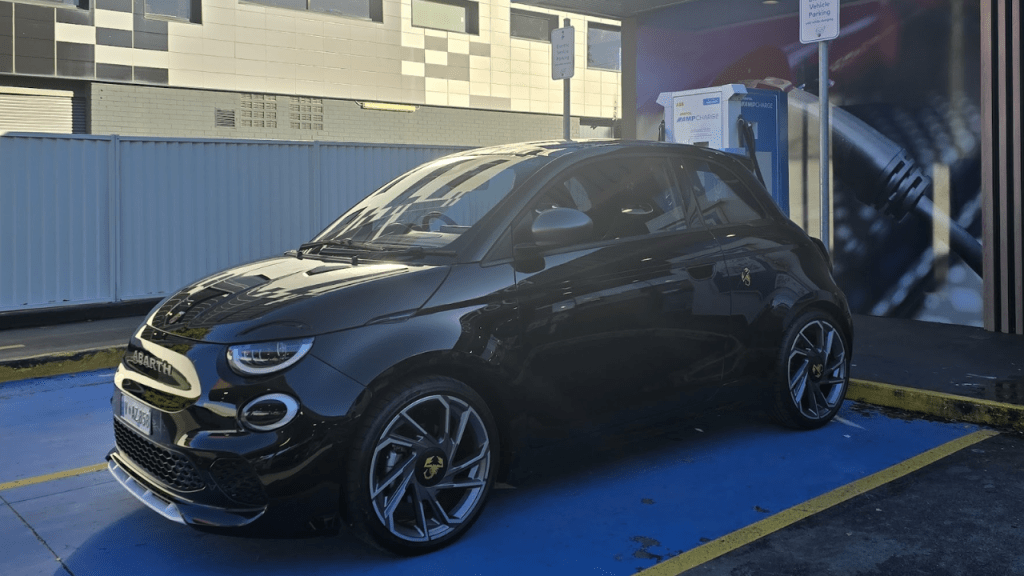
Personally, I didn’t feel confident enough to take this car out of Sydney and to Newcastle, which is a trip I’m usually doing with my reviews. I tend to find it a sensible trip to gauge just how long you can reasonably drive an EV without needing to charge it, with most models tending to circle the 50 per cent point by the time I start charging at the other end.
The 500e would have struggled to even make the trip up, so I met myself halfway at Gosford. This trip required me to charge the car twice – at the Alexandria Ampol in the morning, as I wanted some more juice after the IKEA trip, and at the East Gosford Ampol, to make it back to Sydney. I also charged the car a third time at night at the Ashfield Evie charger.
That is at least two more times I would be charging the Abarth 500e over a car that simply had a bigger battery, but the size of the battery wasn’t the only thing going against it.
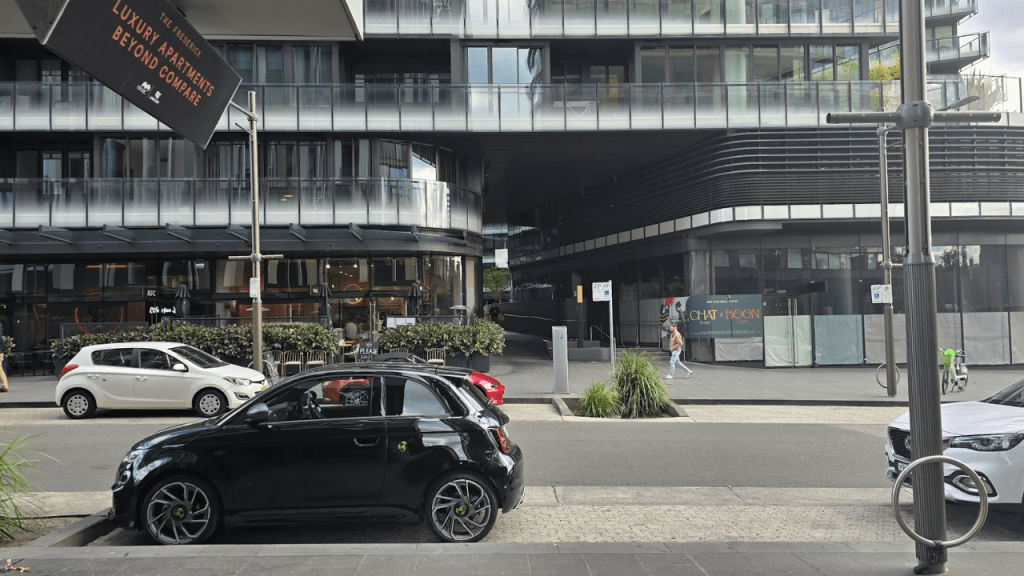
The Fiat/Abarth 500e does not come with a wall socket charger – it instead comes with an 11kW Type 2 to Type 2 charger. This is great if you show up at a public charging station that requires a BYO cable, but these are comparatively rare compared to chargers that have a cable supplied. It’s also great if you have a home charging box installed, but my assumption would be that if you’ve got or are getting one of those, you’ve probably got a separate cable, too.
The lack of the emergency wall socket charger really rubbed me the wrong way, because if I did have it, I could have just charged overnight at home the night before my trip to Gosford, and my night back. I usually rely on wall socket chargers, because I’m a renter who doesn’t have the ability to install a wall box, and I’m typically leaving the car in spots where I can reliably use a wall socket charger overnight, but don’t have access to a wall box.
Admittedly, a wallbox charger will inherently be faster, but a socket charger is just so, so much more practical. I get the mindset: if you’re buying a small city car, you’re probably relying on on-street parking, and can’t sensibly use a wall socket charger. Great! Why not give customers the option to choose one or the other at the checkout, though? I can’t imagine the wall socket charger being more expensive at all.
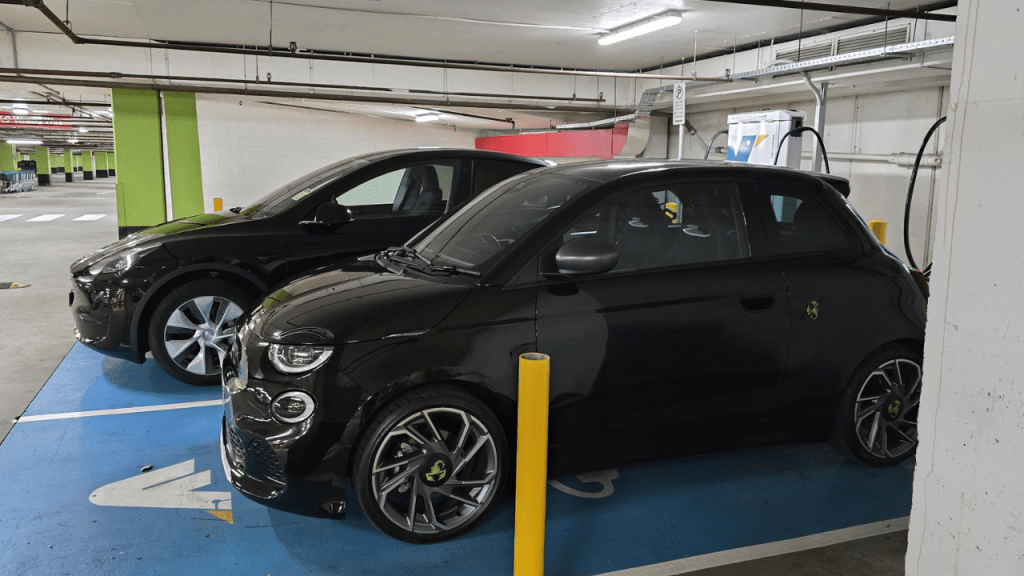
OK, fine, I’ll talk about the noise
We’ve gotten a lot of mileage off calling the Abarth 500e the smallest EV in Australia, but it’s also the loudest. The Abarth model comes with an artificial engine noise that just needs to be heard to believe.
Yes, you can disable it. It’s so goddamn loud that you’ll probably be driving without it on anyway. It actually gave me a headache. I’m a big supporter of EVs making noise, for safety reasons primarily, but this isn’t what I meant. This is an EV pretending it’s burning fumes.
As already said, it’s not available on the standard Fiat variant. Great. I wouldn’t miss it, to be honest.
Driving-wise, the Abarth 500e feels brilliant on the road – I just wish it wasn’t front-wheel drive. It has a brilliant turning circle, it’s confident on its feet, and for as small as it is, the driver’s seat feels fine – just don’t be too attached to electric seating, as positioning is all manual.

Lane assistance was fair, but could not be relied upon to be anything more than a guide. Cruise control was very limited, and there were no car distancing controls. Tech-wise, the only problem I really had with the Abarth 500e was its wireless Apple CarPlay/Android Auto connector – it kept dropping out no matter what. I recommend using the wired version.
This was the first EV I have driven in a while that actually feels like it wants to be driven, though. The Ford Mach-E rides on the tailcoats of the Mustang, sure, but it bridges the gap between a performance model and a family car. The Abarth 500e, probably down to the culmination of all of its sporty aesthetics, from the lime green scorpions across the car to the racing car feel of the steering wheel, really wants you to fling it around.
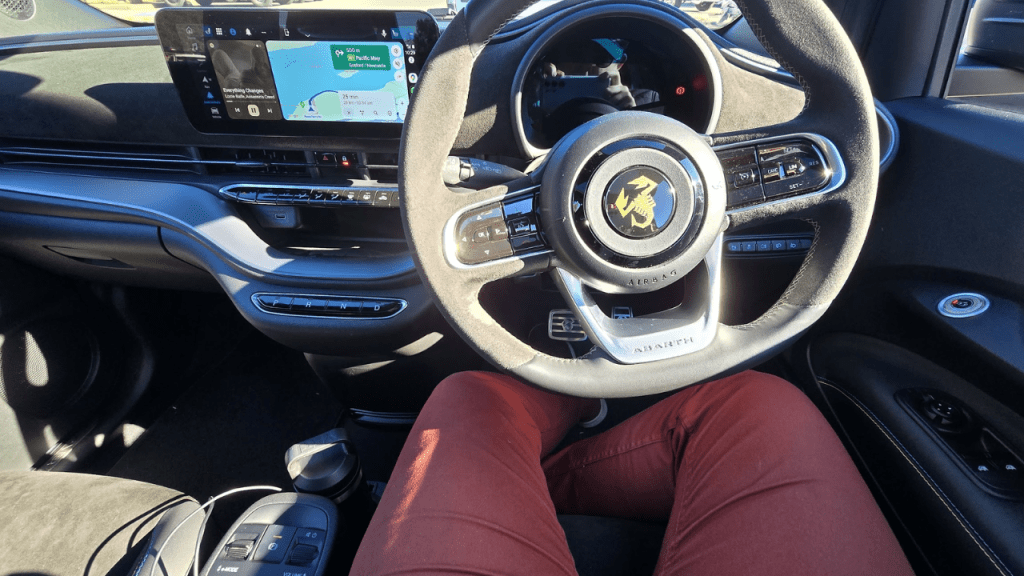
Just, you know… Not for too long, because it’ll need to charge.
The verdict: Should you buy the Fiat/Abarth 500e?
Considering all of this information, how would you price the Abarth 500e, and its lower-priced Fiat brother? Especially when small Chinese hatchback electrics are dominating the entry-point of the market, and the 500e exists in an extreme niche, reliant on a historical badge and a body type no other carmaker is selling down under?
Well, that’s the hardest part of all of this. On MSRP, the Fiat 500e is priced at $52,500. The Abarth 500e is priced at $60,500.
I’m sorry, that’s just too much. It’s already an uphill battle to get so excited about a car that deliberately saws off the bits that Aussie drivers want (range, size, useful tech features), but that’s at least $15,000 higher than what I would reasonably spend on either model.
If you’re after a small electric car in Australia, but also want a reasonable assortment of features and a good battery range, then you’re probably not going to be thinking about the Fiat or Abarth 500e. You’re probably thinking about the MG4 Excite, GWM Ora Extended, or the BYD Dolphin Premium – all cars priced well below $45,000. If you take the 500e at its price points, you’re then considering premium versions of these cars, along with much more capable, albeit bigger cars, such as the Tesla Model 3 or the Model Y.
With all of this mind, I can only recommend the Abarth 500e if you really crave a small, fun-to-drive city car. If you want something that can be reasonably relied upon for moving things around, for families, or for driving out of a major city, then this car is probably not for you.
The Abarth 500e is available now, starting at $60,500 before on-road costs.
